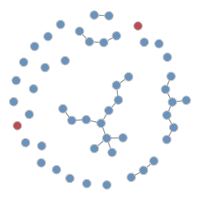45 Introduction
In this module, we demonstrate how to build a research-level COVID model to gain further understanding on how to develop and simulate EpiModel extension models for a real-world disease and research question. The network parameterization remains flexible and straightforward to focus on the new processes relevant for a SARS-CoV-2 transmission model.
We first explore a tutorial that implements demography (aging, births, and deaths) within a model, and then we implement a model with more complex representation of COVID disease history and adds interventions.
45.1 Module Learning Objectives
- Implement an EpiModel extension model that includes demographic changes, including the complexities of handling birth and death in extension models.
- Add a more complex COVID natural history that differentiates symptomatic versus asymptomatic infection after exposure.
- Implement a model with COVID screening and diagnosis that also differentiates symptomatic versus asymptomatic infection.
- Add a simple case isolation intervention for those diagnosed with COVID.
- Develop new network parameterizations with age mixing and age-specific natural history and intervention parameters.
